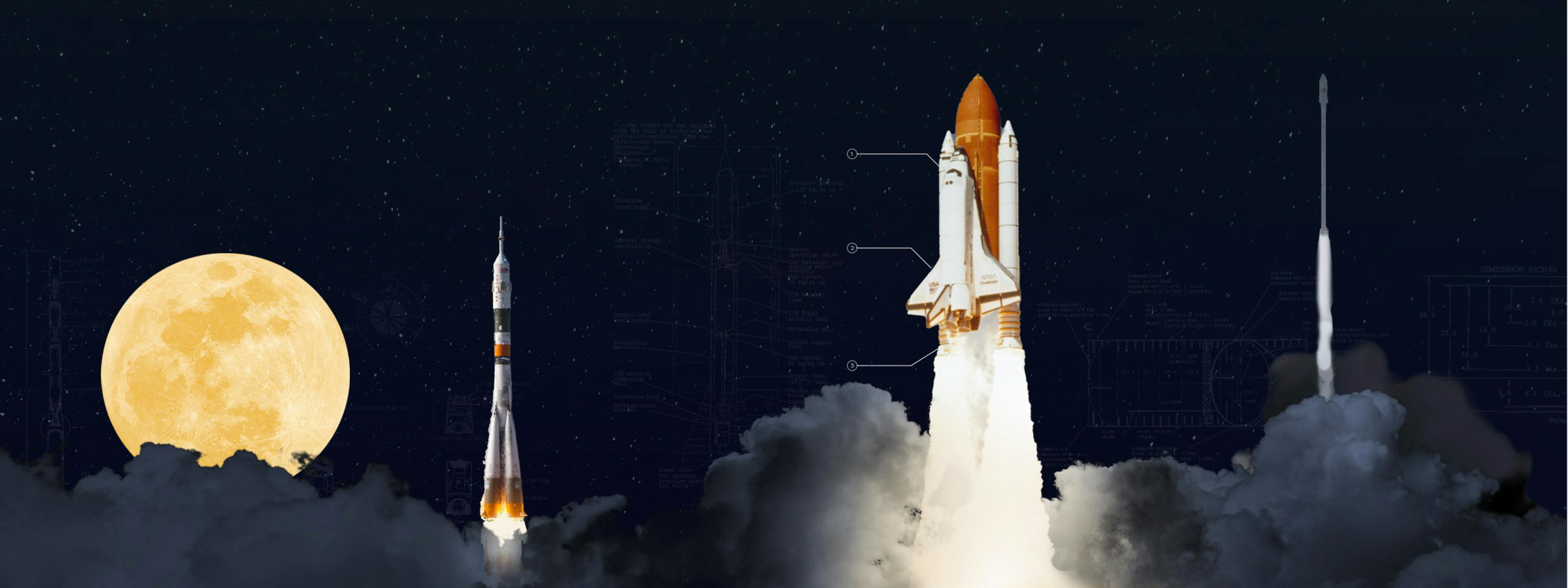Modern rockets evolved out of ballistic missiles, weapons intended to maximize lethality. However today, rockets are being designed with the opposite goal in mind — extending humanity’s reach in our solar system and saving it from any catastrophe that may befall our Earth.
It’s been over fifty years since mankind built its most powerful rocket yet, the Saturn V, which carried astronauts to the moon six times over during the Apollo missions. In all that time, no one has even attempted to outdo the feats that the Saturn V performed — until now.
Not only are we living through a new era of reusable rockets, but we are now within reach of finally placing humans on Mars. NASA and SpaceX are now busy assembling super heavy launchers capable of lifting massive amounts of cargo into space, and the rest of the world is also jumping on the bandwagon. India is finally developing space flight capability and plans to launch its first astronauts into space in 2025, which will make it the fourth country in the world to do so after Russia, the US, and China. Meanwhile, Russia and China are dreaming of moon bases as they separately make preparations to one day take their own first steps on the moon.
After a decades-long drought, the global space industry is booming once again, setting the stage for a new space race for the ages.
The State of Rocketry
Rocketry has always been a boom-and-bust business. Booming in times of war, while going bust in times of peace or economic uncertainty. The end of the twentieth century, a notably quiet period free of open global conflict, also presaged a decline in our cosmic ambitions.
The last manned Space Shuttle mission flew to space in 2011. Though there had been attempts to revive NASA’s ambitious mandate by President George W. Bush, who hoped that the Ares program would successfully produce a series of rockets capable of taking Americans back to the moon, this program was canceled by President Barack Obama after a series of cost overruns and the onset of the Great Recession in 2008. The Artemis program was greenlit in its place, with a mission to return Americans to the moon in order to build a lunar base, albeit on a delayed schedule, and largely using legacy technology.
The ups and downs of terrestrial economics and military engagements must have frustrated space enthusiasts, who no doubt shared the view of one of NASA’s progenitors, Wernher von Braun, who said while announcing the launch of the Saturn V, “we have been given the scientific knowledge, the technical ability and the materials to pursue the exploration of the universe. To ignore these great resources would be a corruption of a God-given ability.”
After witnessing the shuttering of numerous launch systems from the Saturn, Atlas, and Titan rocket families, which once launched American satellites and astronauts into space, a handful of individuals decided to take matters into their own hands. Their efforts were led first and foremost by Elon Musk.
After SpaceX shocked with world by producing the cheapest rocket ever built in 2006 and then unlocking the trump card of rocket re-usability, a number of companies were birthed to follow suit. While companies like SpaceX, Northrop Grumman, United Launch Alliance, Rocket Lab, Firefly Aerospace, and ABL Space Systems already possess active launch systems, more are on the way. Soon, Relativity Space, Blue Origin, SpinLaunch, and Astra Space hope to produce systems capable of taking payloads to orbit themselves.
The gears of the space economy are starting to turn yet again as an average of 50 new satellites per week take to orbit. Over the past forty years, the cost of launching cargo into space has fallen by 95%. Whereas in the 1980s, the Space Shuttle was capable of transporting a kilogram of payload into low earth orbit for $65,000, SpaceX’s Falcon Heavy can now do the same for just $1,500 a kilogram. However, this is just the beginning. Within a few years, even Falcon Heavy’s accomplishment will be outdone more than ten-fold when SpaceX’s Starship drops that cost to under $100 per kilogram.

Source: Encyclopedia Britannica
Prior to the era of re-usable rockets, the cost of sending anything into space cost as much as the entire rocket itself. This meant that only a sparse handful of extremely valuable projects, like massive telecommunications satellites or global positioning systems could qualify. Today, as the space industry gears up to manufacture reusable rockets en masse, the cost of launching payloads into space will undoubtedly plummet, opening up the playground of space to all.
In the coming years and decades, you can expect a lot more activity to start taking place in space, from the erection of multiple moon and interplanetary bases, the construction of numerous space stations, and certainly, greater and more ambitious manned missions through the cosmos.
The Basic Principles of Rocketry
A rocket is a self-propelled projectile, meaning that it carries with it all the resources it will need to take flight. It’s this crucial point that separates rocket engines from all others and allows rockets to propel themselves through the vast void of space. Jet engines, for instance, rely on oxygen in Earth’s atmosphere to combust the fuel they carry. In space, there is no oxygen, which means that rockets need to carry the oxidizer required for combustion on board with them.
A rocket’s engine combines this oxidizer and fuel together in a massive reaction to produce enough thrust to lift the mass of the rocket off the Earth. The magic of rocket engines, of course, is that they can direct the force of this chaotic explosion in one direction: downwards. This is what produces the continuous thrust required to push it off the ground.
For rockets to achieve liftoff, the force of the thrust expelled through the bottom of the rocket must exceed the force that Earth’s gravity exerts on the rocket. However, getting rockets off the ground is just the first step.
In order to get a rocket beyond the pull of Earth’s gravitational field, the rocket will need to produce enough thrust to accelerate to a velocity greater or equal to 11 kilometers per second — Earth’s escape velocity.
This is a figure that is independent of mass. Anything traveling at this speed, whether it be a leaf, a mountain, or a shoe is sure to exit Earth’s orbit. It is the task of the rocket engineer to figure out what kind of fuel and engine mixture will be capable of meeting both of these conditions — lifting the mass of the rocket, and accelerating it to the correct velocity.
Elon Musk once said, “We live on a planet where [achieving escape velocity] is just barely possible. If gravity were a little lower, that would be easier, if it was a little higher it would be impossible.”
As the fuels currently available to us are limited, we only have so many options for how to produce the required combustion reaction to achieve the necessary thrust to leave orbit. Luckily for us, as Elon Musk pointed out, this is just barely possible. If Earth’s radius were just slightly greater and its gravity slightly higher, we might have been confined to Earth’s atmosphere forever.
It’s worth noting that while we’ve succeeded in launching numerous probes into deep space, like the Voyager 1, which is now in interstellar space, over 15 billion miles away, the vast majority of space missions, from the Apollo missions to SpaceX’s Falcon 9 launches, never needed to reach escape velocity since their destinations were always confined to Earth’s orbit, whether to step onto the moon or deliver a satellite.
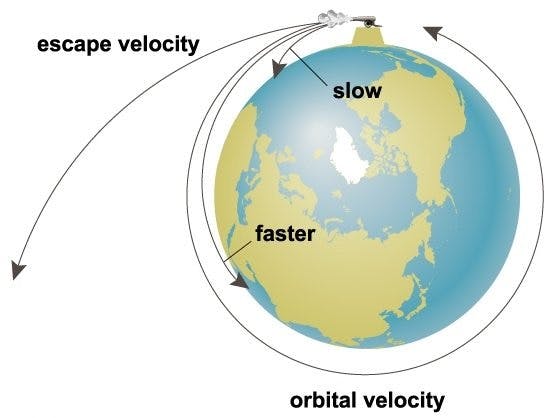
Source: John M. Jennings
Still, managing to carry enough fuel while trying to minimize the total mass of the rocket is a difficult balancing act. The positive side of this is that as rockets expend fuel, they get lighter. The less mass a rocket has, the easier it is to accelerate.
Rocket fuel is contained in giant cylindrical tanks, which are what we normally think of when we imagine a rocket. Once that fuel is spent, it’s better to get rid of the empty tank, which is then just dead weight. This is what all rockets do via a technique called staging.
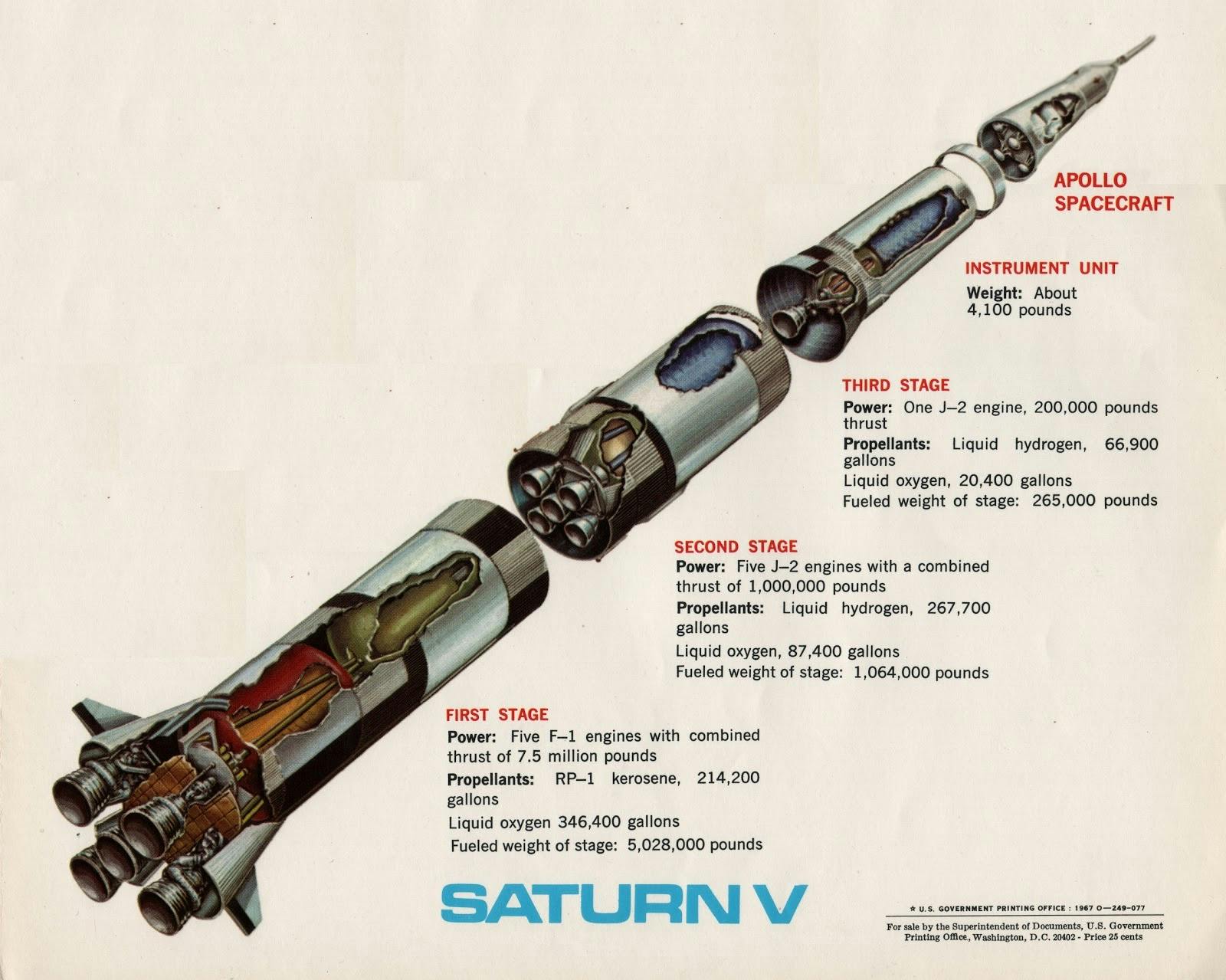
Source: Phys.org
The full trajectory of a flight is divided up where the fuel for the first part of a trajectory, for example to a point just outside the Earth’s atmosphere, is contained within the first stage. Once the targeted altitude is hit, that stage is shed and falls back down to Earth. Further stages also carry fuel, which allows the lighter rocket to propel itself onward. By this point, less fuel is needed since beyond the Earth’s atmosphere there’s no air resistance impeding the rocket’s speed and Earth’s gravity is substantially weaker. Most modern space missions are designed in two to three stages, where the final stage delivers the payload — crew or equipment — into orbit.
There have been attempts to produce a rocket that does not require staging called a “single stage to orbit spaceplane.” One such design was proposed by Lockheed Martin via its VentureStar spacecraft. However, after numerous attempts, its developers found that the amount of fuel required to carry onboard was simply too much to get the spacecraft out of orbit. The project was ultimately canceled in 2001.

Source: NASA
While it may be possible to produce a single-stage spaceplane, for that to happen, some rather amazing engineering breakthroughs will need to take place since the traditional fuels available to us now will not be sufficient.
Though rocket design differs according to the missions they were built for, the discipline has settled on a common anatomy capable of dealing with engineering constraints. All rockets today have a similar structural system composed of a cylindrical body, fins, and a pointy nose cone. The vast majority of the body is taken up by the rocket’s propulsion system, which includes the engine and separate tanks containing fuel and oxidizer. Each rocket also contains guidance systems with computers capable of controlling the rocket’s balance, direction, and various maneuvers in flight.

Source: NASA
At the very top of the rocket, inside the nose cone, is the payload system, which contains either a capsule with crew or equipment to be deployed. Given the immense quantity of fuel required to push the rocket into orbit, the payload typically comprises just two percent of the entire weight of the rocket.
Whereas satellites might not mind the cramped space, the historic conditions of space travel for human crew were very psychologically taxing indeed, particularly for long missions.
For most manned missions, crew members had to sit cramped and hunched over in tiny capsules designed for just one or two astronauts. With no room to stand up or move around, all activities from mission control to regular bodily functions had to be done sitting in the same position. It’s particularly amazing imagining how astronauts like Frank Borman and Jim Lovell fared sitting inside the Gemini capsule as they orbited the Earth for a total of 13 days in 1965.
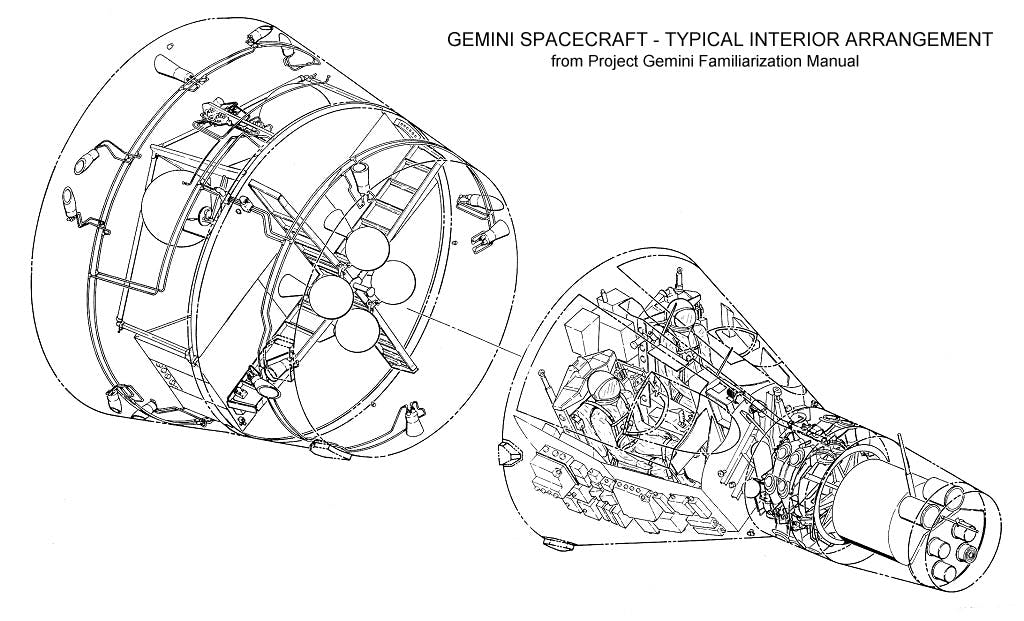
Source: NASA
A History of Rocket Technology
Though today’s rockets call to mind images of deep space exploration and the boundlessness of human curiosity, for most of humanity’s history they were used for one thing: war.
The Chinese are said to have been the first to use gunpowder rockets, which they used in military applications around 1200 CE to defend against Mongol invaders. These early rockets were comprised of a mixture of potassium nitrate, sulfur, and charcoal tied to a large bamboo stick.

Source: ThoughtCo
There is some dispute over how the secret of gunpowder first came to Europe, whether it was through Marco Polo, who brought the idea back to the European continent after his travels to China, or whether it was Roger Bacon, the Franciscan monk who independently developed a formula for gunpowder in his study. Either way, gunpowder rockets began being employed in European conflicts by the 14th century. But not for long.

Source: Eugène-Emmanuel Viollet-le-Duc
The invention of the cannon, which supplied greater precision and destruction, quickly eclipsed the role of rockets in battle. For the next 400 years, gunpowder rockets were relegated for use as mere signaling devices or flares in military incursions.
By the 19th century, however, the British revived the use of rockets in battle when they devised two new and devastating weapons: the shrapnel rocket and the incendiary rocket. The former contained a payload of rifle balls that exploded atop enemies on the battlefield, showering them with deadly metal shards and bullets. The incendiary rocket, meanwhile, carried a flammable material at its tip which could set its targets on fire. Britain’s use of these destructive rockets in battle was immortalized in the Star Spangled Banner; the “rockets’ red glare” refers to the English rocket attack upon Fort McHenry in the War of 1812.

Source: Americana Corner
The British inventor William Hale sought to improve the precision of rocket flight by helping control their spin. In 1844, Hale pioneered his “spinning rocket” which used a technique called spin stabilization to better direct its trajectory. He achieved this by including two holes at the rocket’s base through which exhaust gasses could escape, causing the rocket to spin about its longitudinal axis. The US government bought the rights to Hale’s rocket designs, which it employed in the Mexican-American War. However, rocket technology was soon overtaken by conventional artillery and it made no further significant strides as a weapons technology until the dawn of the Second World War.
The Fathers of Astronautics
Remarkably, it was exactly in this period of relative quiet for military rockets that the foundational theory and science behind rocketry began to be established. During the 1920s, three individuals took it upon themselves to investigate the limits of rocketry for themselves, and in doing so, laid the foundations of the field as it stands today.
These pioneers included a Russian named Konstantin Tsiolkovsky, an American named Robert Goddard, and a German named Hermann Oberth. All three of them worked independently, and without any knowledge of their contemporaries discovered the essential principles necessary for space flight. Today, these three are collectively known as the fathers of astronautics.
Remarkably, Tsiolkovsky was a nearly deaf schoolteacher. Despite being almost entirely cut off from all scientific activity of his time and living in a small rural village, he still managed to produce incredible prescient, almost prophetic conclusions about the requirements for space travel.

Source: Eotvos Lorand University
Tsiolkovsky was able to accurately deduce the escape velocity needed to leave Earth’s orbit, and created the famous “rocket equation” which describes how a rocket’s upward velocity changes as a function of the exhaust velocity of its expelled propellant and of the rocket's mass. If that’s not enough, he also independently came up with the idea for a multi-staged rocket, which he called a “rocket train.” After he died, his epitaph was inscribed with the phrase “Mankind will not remain tied to the Earth forever.”
While Tsiolkosvky produced incredible works of theory, he never tested out his ideas with real rockets. Instead, it was Goddard, the American, who constructed the first liquid-fuel rocket in March 1926. His simple rocket filled with gasoline and liquid oxygen rose 39 feet into the air and traveled roughly two football field lengths into a neighboring field in Massachusetts. Within a few years, however, Goddard had built rockets that could fly faster than the speed of sound at heights over 20 times the altitude of his first ascent. His work went unrecognized by the US government until he died in 1945.
Finally, Oberth was known for his publications emphasizing the importance of liquid-propellant rockets, multi-stage rockets, and guided re-entry systems. He was the only one of the three fathers of astronautics who spent any time working on a government space initiative — Germany’s. In fact, it was Germany that succeeded in launching the first ever modern rocket in 1942. Intended for use as a ballistic missile, it was named the V-2 rocket, which stood for “vengeance weapon number two.”
When the Allies won the Second World War, the German military space program was disbanded, with the majority of Germany’s rocketry team surrendering to the Allies. One German engineer in particular became pivotal to the United States’ eventual successes in space — Wernher von Braun.
After helping design the V-2 rocket in Germany, von Braun then worked for the American ballistic missile program. He helped design the Redstone rocket which took two Americans into suborbital flight for the first time in 1961, the Explorer-1 which launched the first American satellite into orbit, and oversaw the development of the Saturn family of rockets, with the Saturn V being the rocket which ultimately carried the Apollo missions to the moon.

Source: Forbes
However, the period of relative peace after the end of the Cold War once again imposed a quieting effect on the field of astronautics. NASA’s budget was progressively slashed year over year, while the number of active launch systems declined. That is, until now.
A Golden Age of Rocketry
When we look back upon the twenty-first century, one of the most extraordinary achievements we identify will surely be SpaceX’s success in creating reusable first-stage rockets.
After flying more than 70 kilometers into the atmosphere at speeds exceeding 8,000 kilometers per hour, SpaceX’s Falcon 9 boosters, which weigh more than half a million kilograms and tower at an imposing 70 meters, can land themselves upright, on a target, within an accuracy of 10 meters.
Watching footage of a Falcon 9 booster fly itself back down to Earth from its incredible atmospheric flight is perhaps one of the most marvelous displays of our era’s technical abilities.
What’s even more impressive is how quickly the SpaceX team managed to accomplish this incredible feat. It took just four years from the time they announced the launch of their re-usability program in 2011 to their first successful landing in 2015.
For nearly sixty years before this, rocket missions would let their first stages crash down to Earth, in the case of Russia or China’s space programs, or crash into the ocean in the case of the US’s space program. However, doing so would be the equivalent of destroying a plane after it arrived at its destination.
Instead of being destroyed on impact, SpaceX’s Falcon 9 rocket re-orient itself in mid-air after separation using four nitrogen gas thrusters on board. Then, it lit up three of its nine engines to add upward thrust and slow its downward velocity in what’s called a “boost-back burn”, after which it unfolded four compact grid fins and prepared for atmospheric re-entry. Falling through the atmosphere, it tilted its grid fins to control its descent toward the landing pad at which point three engines would light up one final time to unleash a powerful burn reducing the rocket’s velocity to zero, while landing gracefully with the help of four retractable legs.
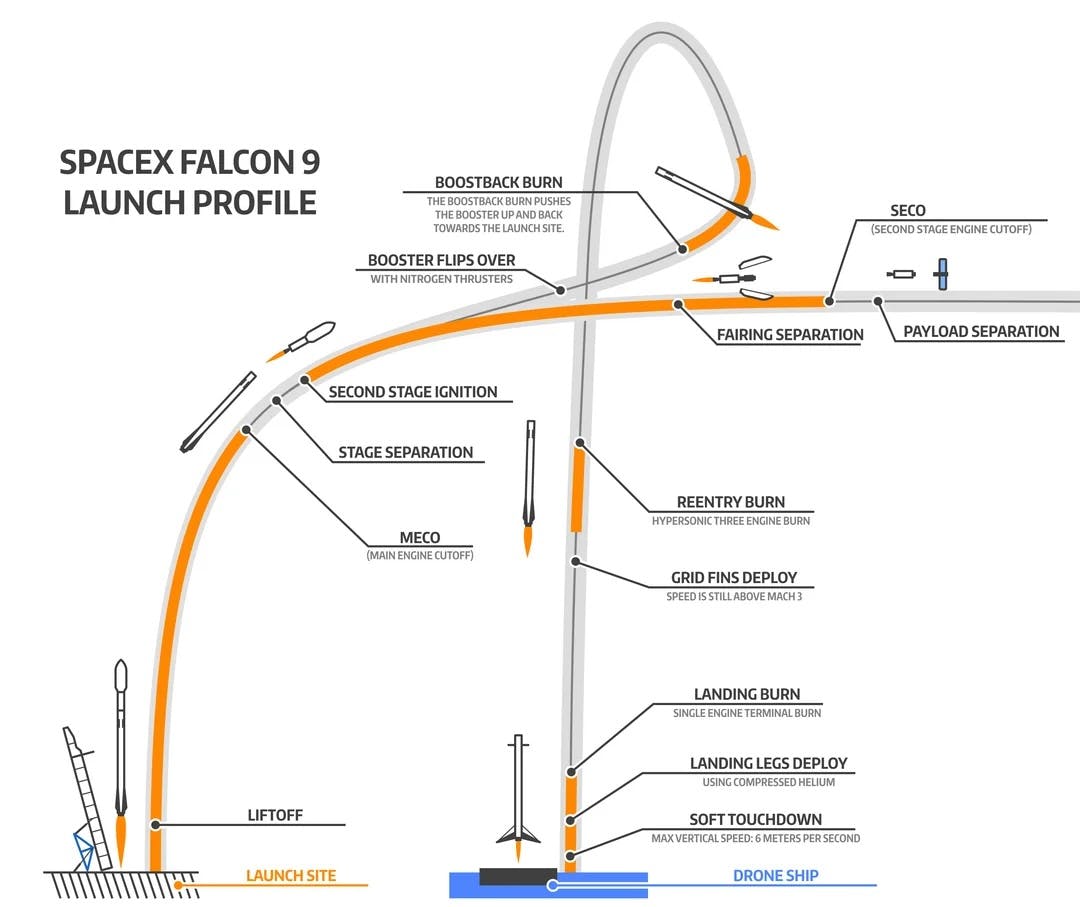
Source: Meiobit
As if that wasn’t miraculous enough, SpaceX then decided to test out this reusable rocket technology on its Falcon Heavy rocket — an ambitious design that strapped three Falcon 9 boosters together to carry up to 64 metric tons of payload into low earth orbit. The idea was that with Falcon Heavy, all three Falcon 9 boosters would return down to earth after their staged separation.
The Falcon Heavy was a massive undertaking that ultimately required a near-total redesign of the rocket system. The core booster needed to be structurally reinforced and re-cast out of an ultra-strong lithium and aluminum alloy to withstand the extreme vibrations and acoustics it suffered from the two boosters that flanked it side-by-side.
After a few mishaps, all three stages finally performed a coordinated landing back on Earth in 2019. The Falcon Heavy, which costs approximately $100 million per launch, will be the only remaining solution for carrying heavy cargo into space, after its nearest competitor, United Launch Alliance’s Delta IV, which boasts a price tag of over $400 million per launch, retires in 2024.
Replacing the Delta IV, the Falcon Heavy will fly at least four missions in 2024. These include the Europa Clipper mission which will send a NASA-made orbiter to investigate the subsurface of one of Jupiter’s moons, the Viper mission, which will send a rover to the moon’s southern pole, and beginning in December 2024, Falcon Heavy will participate in NASA’s Lunar Gateway mission, delivering crucial cargo to build one of the first outposts on the moon.
The Future of Spaceships and Space Logistics
Despite the cost savings already achieved by Falcon Heavy, this system will soon be retired when SpaceX’s Starship is completed. Starship, if all goes according to plan, will completely reshape our understanding of what is possible to do in space. It will become the workhorse of the space economy, shuttling hundreds of tons of cargo into low earth orbit and beyond on each trip. It will help construct new space stations and moon bases for pennies on the dollar, and it will help humanity become an interplanetary species for the first time.
When completed, this behemoth will stand over 387 feet tall and measure 30 feet across. When fully fueled, it will weigh 1400 tons and be capable of carrying an additional 150 tons into orbit.
Starship, also known as the ‘Big Falcon Rocket’ is composed of two parts, the Super Heavy, a first-stage reusable booster, and the upper stage, which is the Starship spacecraft itself. Unlike most other crew-carrying vehicles, which were really just capsules, Starship will be an actual ship, capable of carrying a 100-person crew, first to the moon, and eventually to Mars.

Source: The Independent
However, perhaps one of the most significant things Starship will unlock is the ability to refuel in orbit. This will unlock far greater possible mission durations than what is possible with rocket staging techniques alone. In the past, rockets would need to carry all the fuel they needed on board with them. With orbital refueling and reusable rockets, the design for long-duration flight missions changes completely.
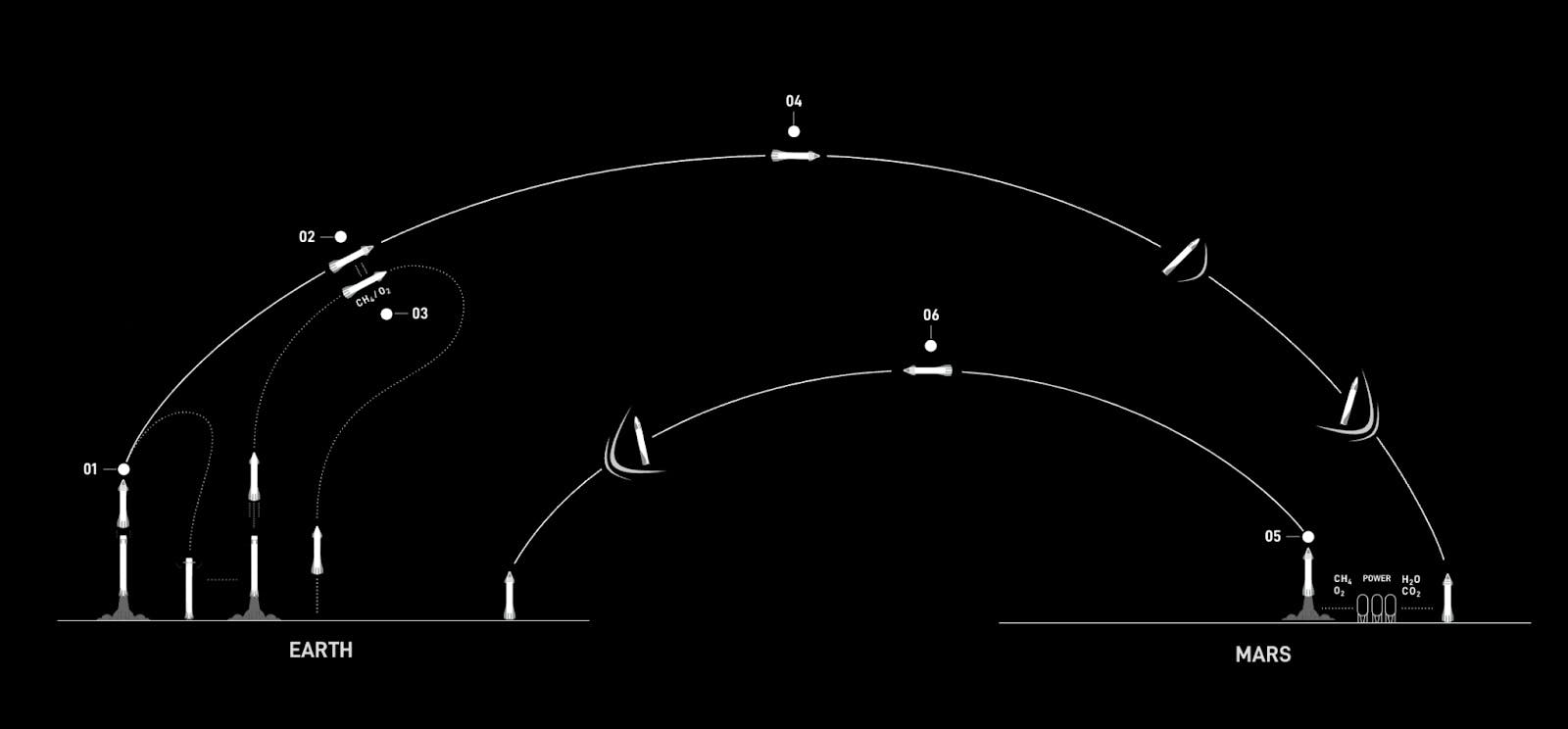
Source: SpaceX
SpaceX has designed an entirely new engine to perform Starship missions called the Raptor engine. Rather than relying on traditional rocket fuels like RP-1 or hydrogen gas, it uses a methane-based fuel. As a fuel, methane is not the most energy-dense or lightweight fuel available. Instead, what’s special about it is that it can be produced on the surface of Mars.
Using techniques very similar to what carbon utilization technologies employ when sequestering atmospheric carbon dioxide to turn it into natural gas, the Starship will be capable of producing its own methane fuel using only the carbon dioxide and water found in the Martian environment.
To make this vision work, SpaceX will need to produce hundreds of Starships and Super Heavy boosters. This is why the company is planning to scale its operations in Starbase, Texas to produce a factory line eventually capable of churning out one Starship per day.
While Elon Musk has set the goal of launching a manned mission to Mars by 2027, we are still waiting to witness a successful demonstration of Starship’s abilities. The only flight test to date, which occurred on April 20th, 2023 ended in a rapid unscheduled disassembly, i.e. an explosion. However, within six months, the SpaceX team has already made over one thousand changes to the previous design, as it gears up for its second flight test. This rate of innovation and optimization is what characterizes SpaceX.
When viewed as a whole, SpaceX’s rocketry innovations have catalyzed the rebirth of an industry. It has re-ignited NASA’s ambitions to reach for the moon once again, like with the launch of the Space Launch System (SLS) which plans to take a manned crew to the moon through the Artemis program. It’s telling, though, that SLS plans to accomplish this with single-use rockets composed of legacy engine technology. SpaceX has also inspired a number of companies to find other ways of decreasing the costs of space travel, like Relativity Space, which successfully launched an in-house 3D-printed rocket in March of 2023.
We are entering a period where engineers are daring to question and re-engineer every part of what we once thought we knew about space travel.
Disclosure: Nothing presented within this article is intended to constitute legal, business, investment or tax advice, and under no circumstances should any information provided herein be used or considered as an offer to sell or a solicitation of an offer to buy an interest in any investment fund managed by Contrary LLC (“Contrary”) nor does such information constitute an offer to provide investment advisory services. Information provided reflects Contrary’s views as of a time, whereby such views are subject to change at any point and Contrary shall not be obligated to provide notice of any change. Companies mentioned in this article may be a representative sample of portfolio companies in which Contrary has invested in which the author believes such companies fit the objective criteria stated in commentary, which do not reflect all investments made by Contrary. No assumptions should be made that investments listed above were or will be profitable. Due to various risks and uncertainties, actual events, results or the actual experience may differ materially from those reflected or contemplated in these statements. Nothing contained in this article may be relied upon as a guarantee or assurance as to the future success of any particular company. Past performance is not indicative of future results. A list of investments made by Contrary (excluding investments for which the issuer has not provided permission for Contrary to disclose publicly, Fund of Fund investments and investments in which total invested capital is no more than $50,000) is available at www.contrary.com/investments.
Certain information contained in here has been obtained from third-party sources, including from portfolio companies of funds managed by Contrary. While taken from sources believed to be reliable, Contrary has not independently verified such information and makes no representations about the enduring accuracy of the information or its appropriateness for a given situation. Charts and graphs provided within are for informational purposes solely and should not be relied upon when making any investment decision. Please see www.contrary.com/legal for additional important information.

